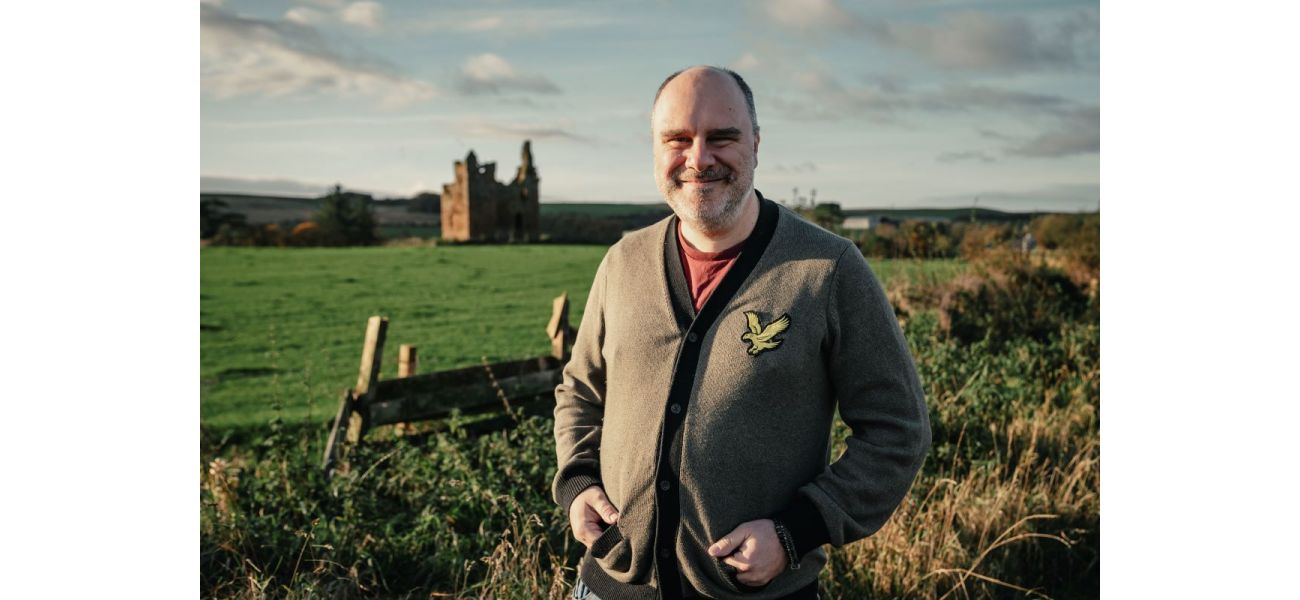Robert Burns' historic Scottish castle to receive £2 million restoration after changing hands to a new owner.
Historic Scottish castle, visited by Robert Burns and potentially inspired Charles Rennie Mackintosh, may undergo £2 million restoration after being sold to a new owner.
December 11th 2024.

A beautiful and historic Scottish castle, once frequented by famous poets such as Robert Burns and John Keats, has been sold to a new owner who plans to restore it to its former glory. Baltersan Castle, located near Maybole in South Ayrshire, has recently been purchased by Italian computer engineer Angelo Ovidi for an undisclosed amount. Ovidi, who now resides in North Wales, first became interested in the castle in 2018 while searching for investment opportunities.
Excited to take on the role of custodian for this magnificent 440-year-old landmark, Ovidi envisions a grand restoration project that will not only preserve the castle's history, but also support the local community. He plans to fund the restoration, at least in part, through the launch of a food and drink brand that will pay homage to the castle's structure.
While the cost of full restoration has been estimated at £2m, Ovidi remains optimistic and eager to work with Scottish specialists, including stonemasons, to bring the castle back to life. "Restoration can be done in different stages," he explains. "The first step is to stabilize the castle, and then address the larger issues. I am determined to work closely with local experts to accomplish this."
The castle was previously owned by a small partnership, led by retired sales professional James Brown, who has a lifelong passion for castles and their history. Brown purchased Baltersan in 1992, with a dream of restoring it as a visitor attraction. He even secured planning permission and a generous offer from Historic Environment Scotland to support the project. Unfortunately, the global financial crash of 2008 put a halt to his plans.
Reflecting on his time at Baltersan, Brown shares, "The architectural and historical value of this castle is exceptional. It's a remarkable place, and I am delighted to have found a new custodian who shares my appreciation for its history and has exciting plans for its future."
Baltersan Castle, built in 1584, is considered a fine example of a Scottish post-Reformation tower-house. It remained mostly unchanged until its last occupants left in 1745, with the exception of a few minor alterations. The castle was constructed by John Kennedy, a bonnet laird, and has strong connections to the Kennedy of Culzean and Cassillis families.
During the notorious feud between the Cassillis and Bargany families, Baltersan served as a secure stronghold with its small courtyards, sturdy iron window grilles, and well-guarded entrance. The castle features many unique architectural elements, such as a split-level hall, a rare rhomboidal oriel window, and a secret chamber. It is also noted that famous architect Charles Rennie Mackintosh sketched Baltersan in 1895, as he was inspired by the Ayrshire landmarks while designing the Glasgow School of Art.
The castle's rich history also includes visits from famous poets, such as John Keats and Robert Burns. In 1818, Keats recorded his visit to Baltersan, while Burns was said to have played in its ruins as a child in the 1760s. Even author Robert Louis Stevenson mentioned the castle in his 1795 poem, "Winter's Walk in Carrick," simply describing it as "dilapidated." At its prime, Baltersan boasted beautiful gardens, orchards, and woodlands.
As Ovidi takes on the restoration project, he looks forward to preserving the castle's history and creating a new brand that will bring awareness to its significance. With a heavy heart, Brown says goodbye to Baltersan, but is confident that it will be saved and restored under the new owner's commitment and vision. To learn more about homes and gardens in Scotland, subscribe to Scottish Field magazine.
Excited to take on the role of custodian for this magnificent 440-year-old landmark, Ovidi envisions a grand restoration project that will not only preserve the castle's history, but also support the local community. He plans to fund the restoration, at least in part, through the launch of a food and drink brand that will pay homage to the castle's structure.
While the cost of full restoration has been estimated at £2m, Ovidi remains optimistic and eager to work with Scottish specialists, including stonemasons, to bring the castle back to life. "Restoration can be done in different stages," he explains. "The first step is to stabilize the castle, and then address the larger issues. I am determined to work closely with local experts to accomplish this."
The castle was previously owned by a small partnership, led by retired sales professional James Brown, who has a lifelong passion for castles and their history. Brown purchased Baltersan in 1992, with a dream of restoring it as a visitor attraction. He even secured planning permission and a generous offer from Historic Environment Scotland to support the project. Unfortunately, the global financial crash of 2008 put a halt to his plans.
Reflecting on his time at Baltersan, Brown shares, "The architectural and historical value of this castle is exceptional. It's a remarkable place, and I am delighted to have found a new custodian who shares my appreciation for its history and has exciting plans for its future."
Baltersan Castle, built in 1584, is considered a fine example of a Scottish post-Reformation tower-house. It remained mostly unchanged until its last occupants left in 1745, with the exception of a few minor alterations. The castle was constructed by John Kennedy, a bonnet laird, and has strong connections to the Kennedy of Culzean and Cassillis families.
During the notorious feud between the Cassillis and Bargany families, Baltersan served as a secure stronghold with its small courtyards, sturdy iron window grilles, and well-guarded entrance. The castle features many unique architectural elements, such as a split-level hall, a rare rhomboidal oriel window, and a secret chamber. It is also noted that famous architect Charles Rennie Mackintosh sketched Baltersan in 1895, as he was inspired by the Ayrshire landmarks while designing the Glasgow School of Art.
The castle's rich history also includes visits from famous poets, such as John Keats and Robert Burns. In 1818, Keats recorded his visit to Baltersan, while Burns was said to have played in its ruins as a child in the 1760s. Even author Robert Louis Stevenson mentioned the castle in his 1795 poem, "Winter's Walk in Carrick," simply describing it as "dilapidated." At its prime, Baltersan boasted beautiful gardens, orchards, and woodlands.
As Ovidi takes on the restoration project, he looks forward to preserving the castle's history and creating a new brand that will bring awareness to its significance. With a heavy heart, Brown says goodbye to Baltersan, but is confident that it will be saved and restored under the new owner's commitment and vision. To learn more about homes and gardens in Scotland, subscribe to Scottish Field magazine.
[This article has been trending online recently and has been generated with AI. Your feed is customized.]
[Generative AI is experimental.]
0
0
Submit Comment





